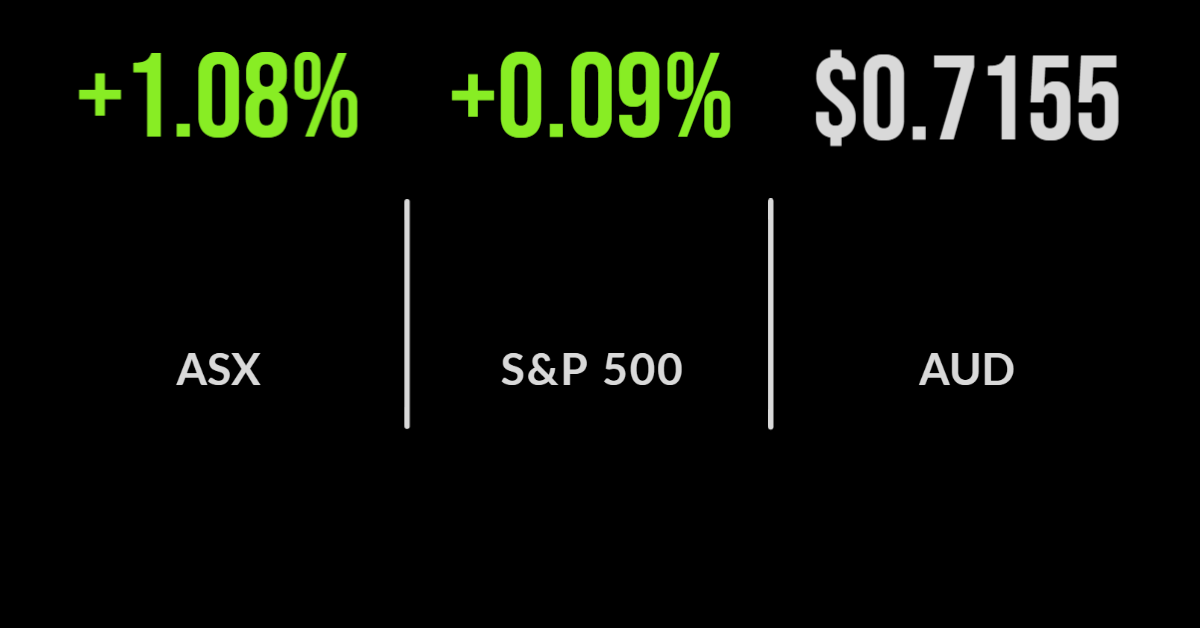Earnings help push local market higher
Healthy earnings results from the likes of CSL, Treasury Wine Estates and Pro Medicus helped to push the Australian sharemarket higher on Wednesday, offsetting losses from the major resource stocks as iron ore and oil prices fell.
The benchmark S&P/ASX 200 Index gained 78 points, or 1.1%, to 7284.9, following a strong lead from Wall Street on Tuesday night, which was helped higher by the tech sector and improved signs of an easing in tensions between Russia and Ukraine.
The broader S&P/AS All Ordinaries index added 82.7 points, also 1.1%, to 7,573, while the S&P/ASX All Tech index rose 25.4 points (1%) to 2,533, while the S&P/ASX 200 Resources index slipped 33 points, or 0.6%, lower, to 5,626.9.
The half-year profit season (full-year, for some companies) is ramping up, and on Wednesday CSL was a highlight, despite the headline interim profit coming in 5% lower than a year ago, at $US1.76 billion ($2.46 billion).
The profit fall came on the back of a decline in CSL Behring’s revenue due to plasma supply issues.
But on the other hand, the vaccine arm, Seqirus, lifted its revenue by 18 per cent on the back of strong growth in seasonal vaccines.
CSL upgraded its guidance and CEO Paul Perreault flagged a return to a “more normalised environment” in January-June after a difficult 2021.
CSL shares gained $20.69, or 8.5%, to $263.69.
Treasury Wine uncorks a ripper
Treasury Wine Estates was another flyer on the market, jumping $1.23, or 11.7%, as the company showed the stock market that the difficulties in its formerly lucrative Chinese market – after Beijing slapped heavy tariffs on Australian wine two years ago as part of a trade/political dispute with Australia – could be overcome.
That, and the pandemic, hit TWE hard, but Penfolds remains a very strong business and reallocating wine to export markets other than China appears to have replaced at least half of the lost Chinese earnings.
While TWE’s net profit fell 7.5% in the December half to $109.1 million, the interim dividend of 15 cents was maintained and investors appeared to reward the company for its reorganised business.
Health imaging IT provider Pro Medicus reported a strong first-half result, with revenue up 40.3% to $44.3 million, and net profit up almost 53%, to $20.7 million, above consensus estimates.
The resources stocks were not a happy hunting ground on Wednesday.
Fortescue Metals Group reported a 32% slide in net profit, to US$2.78 billion, as costs for labour, fuel and shipping all rose.
Fortescue received an average $US96 a dry metric tonne for its iron ore, down from an average of $US114 a tonne a year ago, as the discounts for its lower-grade ore bit hard.
That flowed into the earnings fall. Fortescue paid an 86 (Australian) cents interim dividend, down 41% on the record $1.47 interim dividend announced a year ago.
Santos fell 2.8 per cent to $7.19 despite more than tripling its full-year underlying profit thanks to a rebound in oil and gas prices.
But 2022 oil and gas production guidance fell short of market expectations.
BHP lost 18% to $47.33, Rio Tinto slid 0.2% to $118.56, and Woodside Petroleum fell 0.4% to $26.63.
On the plus side, Liontown Resources surged 25 cents, or 18% to $1.64 after announcing a deal to supply Tesla with more than 100,000 annual tonnes of lithium concentrate over the next five years.
US markets post quiet session
US markets posted tiny changes in the overnight session, with the S&P 500 index pushing minutely higher, up 3.9 points to 4,475.
While the 30-stock Dow Jones Industrial Average lost 54.6 points to 34,934.3 and the tech-heavy Nasdaq Composite Index retreated 15.7 points, to 14,124.1.
The market digested the minutes of the Federal Reserve’s January board meeting, which seemed to affirm plan for interest rate rises at a faster pace than many had expected.
On Ukraine watch, NATO Secretary-General Jens Stoltenberg appeared to cast doubt on the previously reported partial withdrawal of Russian forces from the border area.
Elsewhere, there was some good economic news, with sales for US retailers rising 3.8% in January, well ahead of expectations, and the largest increase since last March.
The Australian dollar is currently buying 72 US cents.








